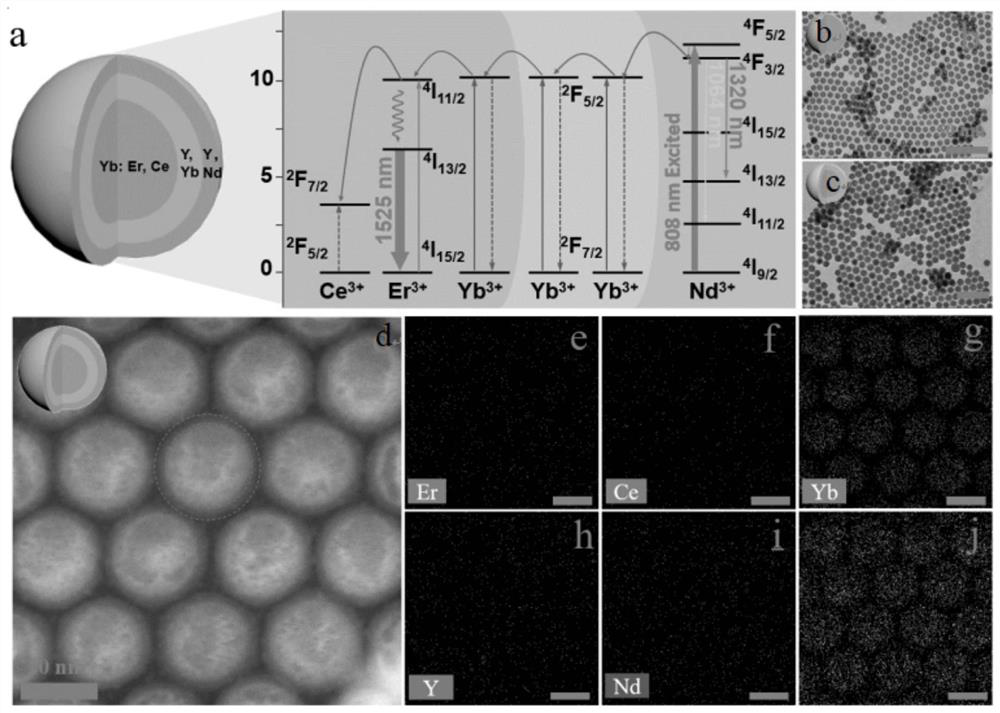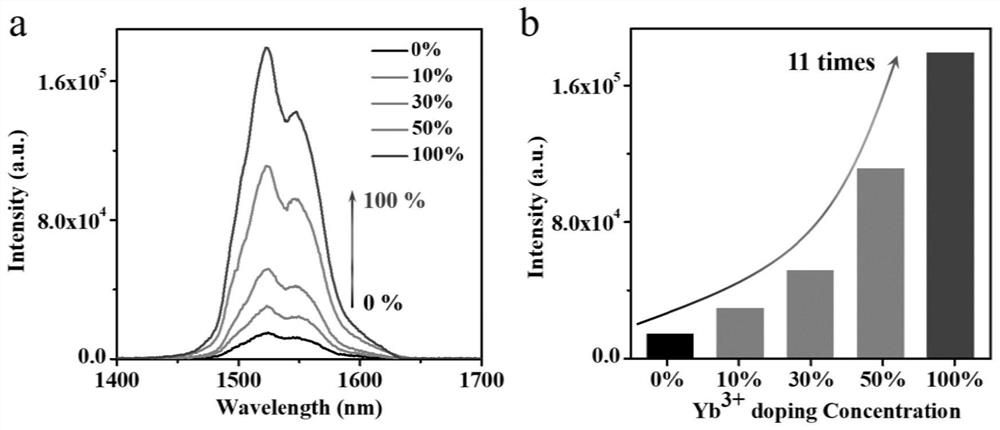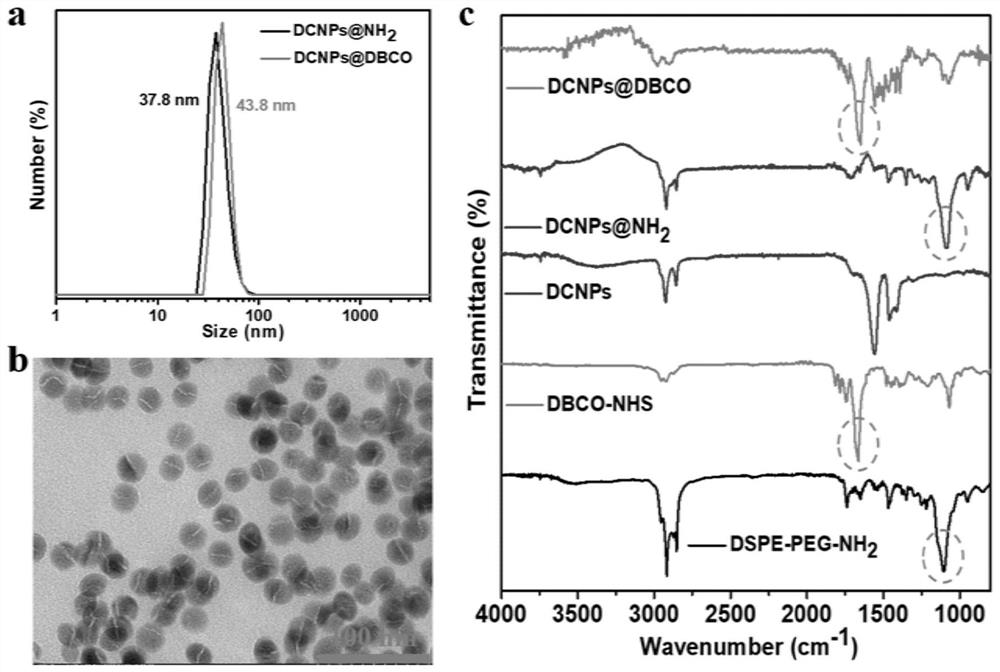Rare earth optical probe and preparation method and application thereof
An optical probe and rare earth technology, which is applied in the field of rare earth optical probes and its preparation, can solve the problems of hindering the efficient enrichment of probes and low ligand binding efficiency, and achieve enhanced tumor enrichment rate and retention time, and good application The effect of foreground, enhanced resolution and signal-to-noise ratio
- Summary
- Abstract
- Description
- Claims
- Application Information
AI Technical Summary
Problems solved by technology
Method used
Image
Examples
Embodiment 1
[0080] Preparation of Rare Earth Optical Probes with Three-layer Structure
[0081] First, NaYbF was prepared by co-precipitation 4 : 2% Er, 2% Ce kernel. 0.96mmol YbCl 3 ·6H 2 O, 0.02mmol ErCl 3 ·6H 2 O and 0.02mmol CeCl 3 ·7H 2 A mixture of O with 6 mL of oleic acid and 15 mL of octadecene was added to a 250 mL flask, and the solution was stirred and heated to 150°C for 60 minutes. Subsequently, after the solution was cooled to 40 °C, 2.5 mmol NaOH and 4.0 mmol NH were mixed 4 F was dissolved in 6ml and 8ml methanol, respectively, then the NaOH solution and NH 4 The F solution was added dropwise to the above rare earth salt precursor solution in turn. After keeping at room temperature for 30 minutes, the mixed solution was successively heated to 50 °C for 30 minutes, heated to 70 °C for 20 minutes, and finally held at 100 °C for 30 minutes to remove excess. methanol and water. Then the solution was rapidly heated to 300° C. and kept for 50 min, the heating was stop...
Embodiment 2
[0087] Evaluation of NIR-IIb Fluorescence Emission of Rare Earth Optical Probes
[0088] The rare-earth optical probes with different Yb doping concentrations are roughly the same as those in Example 1, except that when the second shell layer is coated by thermal cracking, the amount of trifluoroacetate raw material is changed, as follows: NaYF 4 :x%Yb 3+ (x=0%, 10%, 30%, 50%, 100%) shell. (1-x%) / 2mmol prepared Y(CF 3 COO) 3 , Yb(CF prepared by x% / 2mmol 3 COO) 3 , 1mmol CF 3 COONa and 0.25 mmol (2.5 mL) core nanocrystals (NaYbF 4 : 2% Er, 2% Ce NPs) was first added to the mixed solution of 10 mL of oleic acid and 10 mL of octadecene. The mixture was then heated to 120°C for 45 min and then to 300°C for 30 min. Subsequently, the reaction mixture was naturally cooled to room temperature, and the product was obtained by washing with ethanol and centrifugation.
[0089] The fluorescence emission intensity of NIR-IIb obtained by rare-earth optical probes with different Yb ...
Embodiment 3
[0092] Bioorthogonal NIR-IIb Rare Earth Optical Probe
[0093] First, in NaYbF 4 : 2%Er, 2%Ce@NaYbF 4 @NaYF 4 : 30% Nd surface modification DSPE-PEG-NH 2NPs, the specific steps are as follows: 35mg DSPE-PEG-NH 2 (in 2 ml of chloroform) was mixed with 10 mg of DCNPs (in 1 ml of chloroform), stirred at room temperature overnight, and then heated to 60°C to allow complete evaporation of the organic solvent. Then 2 mL of water was added to the above product, sonicated for 10 min, and the NPs@DSPE-PEG-NH was collected 2 , centrifuged at 10,000 rpm for 10 min, washed with water 3 times, and finally dispersed in 2 mL of distilled water.
[0094] Subsequently, DBCO-NHS was combined with NH on the surface of the optical probe through an amidation reaction. 2 connect. Specifically, 1.0 mg of DBCO-NHS was dissolved in a solution containing 200 μL of DMF and 50 μL of TEA, 1 mL of prepared DCNPs@NH2), stirred overnight at room temperature, centrifuged at 12,000 rpm for 15 min, washe...
PUM
| Property | Measurement | Unit |
|---|---|---|
| size | aaaaa | aaaaa |
| size | aaaaa | aaaaa |
Abstract
Description
Claims
Application Information
 Login to View More
Login to View More - R&D
- Intellectual Property
- Life Sciences
- Materials
- Tech Scout
- Unparalleled Data Quality
- Higher Quality Content
- 60% Fewer Hallucinations
Browse by: Latest US Patents, China's latest patents, Technical Efficacy Thesaurus, Application Domain, Technology Topic, Popular Technical Reports.
© 2025 PatSnap. All rights reserved.Legal|Privacy policy|Modern Slavery Act Transparency Statement|Sitemap|About US| Contact US: help@patsnap.com



